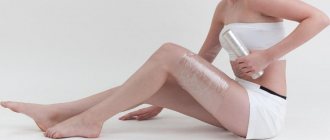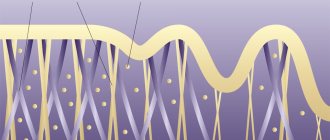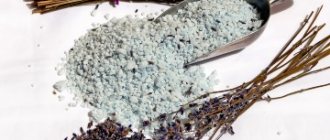In the life of every woman, the second “transitional” age begins - menopause. This is an important period between the reproductive period and complete suppression of ovarian function. The transition to menopause begins at approximately 45-47 years of age and lasts from 2 to 10 years. Estrogens are extremely important hormones for the skin. Receptors for female sex hormones are found in keratinocytes, melanocytes, fibroblasts and other skin cells. A sharp decrease in the level of circulating hormones during menopause inevitably affects the activity of hormone-dependent cells. Age-related changes in the skin due to hormonal changes and deficiency of estrogen and progesterone in women during menopause are called menopausal or biological aging of the skin.
Table of contents
- Etiology and pathogenesis
- Clinical manifestations
- Treatment methods
Loose skin ( sagging skin ) occurs due to loss of elasticity and changes in the architectonics of connective tissue. These changes appear on any part of the body, but are especially pronounced on the face.
In our company you can purchase the following equipment to restore skin elasticity:
- Thermage (Solta Medical)
- Maximus (Pollogen by Lumenis)
- Geneo+ (Pollogen by Lumenis)
PREPARATION FOR PROCEDURES AND RECOVERY PERIOD
To avoid complications, before any cosmetic procedure you should follow the doctor’s recommendations and the rules corresponding to the chosen procedure. In most cases, it is recommended not to visit the beach, solarium, bathhouse, or swimming pool 10 days before and for 1-4 weeks after the procedure. You should also use SPF cream and not take blood thinners.
The recovery period after exposure is usually short or non-existent, such as with alterotherapy with UltheraSystem and Thermage. After some procedures, swelling, slight redness or numbness of the skin may persist for several days. The doctor will tell you more about possible side effects during your preliminary consultation.
Etiology and pathogenesis
Skin laxity is a polyetiological condition, which is influenced by many factors.
One of them is age-related degradation of collagen and elastin - the main proteins of connective tissue. As long as they are present in sufficient quantity and with normal function, the skin appears young and healthy. As the amount of collagen and elastin decreases, their structure and function are disrupted, the skin becomes more and more flabby.
Physiologists have discovered that as the body ages, collagen fibers lose their ability to create an ordered network and begin to stick together with glucose molecules and form non-stretchable threads. The same thing happens with elastin fibers - as soon as sugar joins them, they stop holding water and curl. As a result, the skin becomes flabby, loses elasticity and begins to become covered with deep wrinkles. This process is called glycation - it is believed that it is responsible for age-related changes in the face and body.
Skin laxity can develop due to photoaging . Excess ultraviolet radiation disrupts the functioning of mitochondria, causing a decrease in their ability to capture oxygen and synthesize ATP, which inhibits cell migration and division. UV radiation changes the expression of transforming growth factor β (TGF-β), which is a major regulator of the activity of matrix metalloproteinases that are involved in the remodeling of the extracellular matrix. Ultraviolet light stimulates the release of cytokines that suppress the immune response, disrupts the structure of elastin fibers, reduces the density of the microfibrillar network in the area of the dermal-epidermal junction, and increases the activity of proteolytic enzymes. All this leads to multiple changes in the skin and, in particular, to its sagging.
In patients with inflaming (asymptomatic chronic inflammation of a non-pathological nature), sagging skin develops over time, which is a consequence of deep structural changes, including the dermal matrix. The main pathogenetic mechanisms of this process are spongiosis (swelling of the spinous layer of the epidermis), acidification, chronic hypoxia, activation of matrix metalloproteinases, and a decrease in the synthetic activity of fibroblasts.
After chemotherapy , patients often experience a decrease in skin firmness and elasticity, and skin sagging occurs. These changes develop due to the skin toxicity of chemotherapy drugs.
Sagging skin may appear due to age-related syndrome , which gradually begins to develop in men and women after 40 years. It includes 6 signs: wrinkles, sagging, dry and rough skin, uneven pigmentation, vascular network, changes in facial oval. These changes depend on the level of sex hormones, which, in particular, regulate the formation of the hydrolipid mantle and the functional activity of skin cells.
Finally, if there is a deficiency of microelements , their skin reserves begin to be used up. At the same time, the skin loses elasticity, becomes flabby, dry and ages quickly.
1.Skin aging.
To preserve the beauty given by nature to your skin, you must constantly take proper care of it. Skin care should start from youth. Only in youth the problems are a little different than in older women. If 16-year-old girls solve the problem of oily face and acne, then older women begin to struggle with age-related skin changes.
Age-related skin changes are different, but basically they are:
- loss of skin elasticity
- floating oval
- "bulldog" cheeks
- uneven complexion
- dark circles under the eyes wrinkles and creases
- dark spots
This list can be continued indefinitely. These ugly signs of old age cause anxiety in any woman and she wants to get rid of them by any means and preferably with the help of a magic remedy.
Unfortunately, there is no such magic remedy; you have to fight for beauty.
Look for a selection of the best recipes for anti-aging face masks in the article THE BEST ANTI-AGING FACE MASKS!
One of the ways to combat skin that has lost its elasticity, to tighten the oval shape and get rid of bulldog cheeks, is tightening face masks, which are very easy to do at home and without spending almost a penny.
Clinical manifestations
Externally, loose skin is characterized by decreased tone, wrinkling, dryness, a tendency to sag, and a pale or yellowish tint. These changes can be present both on the face and on the body (abdomen, thighs, buttocks, arms). Morphofunctional changes in loose skin are presented in Table. 1 .
Table 1. Changes occurring in loose skin
| Layer/structure | Changes |
| Epidermis | The dermo-epidermal junction flattens |
| The number of active melanocytes decreases by 8–20% every 10 years | |
| The number of Langerhans cells decreases | |
| The ability to re-epithelialize decreases | |
| The number of pores is growing | |
| Dermis | The thickness of the dermal layer of the skin decreases |
| Vascularization decreases | |
| Collagen synthesis decreases | |
| Pacinian and Meissner corpuscles undergo involution | |
| The structure of the sweat glands is disrupted, their number decreases | |
| Elastic fibers degrade | |
| The number of nerve endings decreases | |
| Hypodermis | Changes in subcutaneous fat distribution |
| The total volume of subcutaneous fat is increasing | |
| Appendages | Hair loses its natural pigmentation and becomes thinner |
| The structure of the nail plates changes | |
| Sebum production decreases |
Treatment methods
Treatment of loose skin should be aimed primarily at identifying the main causes of this condition. It should be taken into account that it is not possible to completely stop the chronological aging of the body - all modern methods are aimed at slowing down and/or correcting existing skin changes.
Non-invasive methods
One of the most common methods is the use of cosmetics . It works best as a preventative - moisturizing, nourishing, protective and other cosmetics are recommended to be used before the appearance of sagging skin in order to delay its appearance as much as possible.
The condition of the skin can be improved by oral intake of antioxidants and vitamins (A, C, E) - this helps compensate for the negative effects of oxidative stress on the skin.
In the presence of inflaming , the following strategy is used: first, the skin must be protected from damage by ultraviolet radiation, excessive dryness, physical factors (UV filters, emollients, moisturizers, etc.), then inflammation is stopped (antioxidants, anti-inflammatory agents) and itching is reduced (neurosensin), after why complex post-procedure care is prescribed to restore the integrity of the skin (ceramides, free fatty acids, waxes, saturated fatty alcohols, etc.).
, menopausal hormone therapy (MHT) has some benefit . Androgens are more relevant for male skin, as they increase the rate of cell renewal in the epidermis, increase the activity of the sebaceous glands, expand pores, and stimulate the production of collagen and elastin in the dermis.
Invasive methods
To correct sagging skin, various injection methods are used - for example, platelet-rich plasma ( PRP ) , which activates collagen synthesis, keratinocyte proliferation and the formation of hyaluronic acid.
is quite popular . Lifting threads stretch and straighten sagging and wrinkled skin, biostimulating threads locally improve metabolism (increase blood circulation, activate regenerative processes, etc.), reinforcing threads occupy an intermediate position between the two above types.
invasive carboxytherapy can be used - the injection of carbon dioxide under the skin with a special injector.
One cannot fail to mention plastic surgery as a powerful method of skin tightening. Its high effectiveness is offset by its equally high morbidity, as well as a large number of contraindications and possible complications.
Hardware methods
Ultrasound, radiofrequency and laser treatments are used to treat sagging skin. Since sagging skin is a consequence of changes in all layers of the skin and subcutaneous fat, priority is given to those techniques that can act at a greater depth. For example, Thermage and Maximus devices provide tissue heating to a depth of up to 5 mm without damaging the epidermis. This is quite enough to start the process of synthesis of a new structural matrix and make the skin more elastic.
Questions from our users:
- loose facial skin
- loose skin under the eyes what to do
- loose facial skin what to do
- loose facial skin, loss of tone
Help from a cosmetologist
It is possible to remove a problem such as sagging facial skin, but for this you need to provide an integrated approach. If you have eliminated the cause of sagging, then now you should think about giving up bad habits, eating balanced food, and proper physical activity. All these points are very important for restoring the condition of the skin. These principles are considered important to maintain elastic, healthy skin.
Every woman performs some kind of cosmetic procedure to improve her facial skin. This can be done in any salon. Flabby facial skin and how to deal with it? Experts suggest carrying out the following procedures in case of sagging skin:
- laser therapy. Here defects are eliminated and the skin is rejuvenated. All this is done using a laser;
- photorejuvenation. The skin is exposed to pulses of light;
- peeling. Those cells that are already dead are removed;
- mesotherapy. Substances that are biologically active are injected under the skin;
- biorevitalization. Here injections are made, during which hyaluronic acid is injected under the skin.
If you use one of the above procedures, you can achieve the desired result quite quickly and remove sagging skin. However, there is a common drawback - such procedures are quite expensive.








